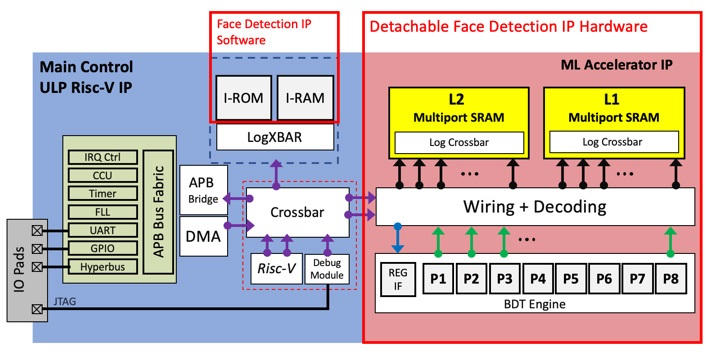Sponsored by CSEMOct 23 2020
Incorporating face detection systems into a single low-power and low-cost element reveals new perspectives in products necessitating safety, security, or people awareness – this is due to the fact such a component can control basic functions such as standby operation, access control, etc.
Here a system-on-chip supporting an accelerated machine-learning algorithm with state-of-the-art optics and packaging has been devised to meet this challenge.
Such a component should be low-cost and combine a sophisticated system with an optic, imager, and the SoC should not take up more than ½ cm3. The desired packaging for this system encases a compact lens, whilst still generating a sharp image with a small track length, and an SoC with the dedicated face detection algorithms.
Optics
A commercial off-the-shelf (COTS) lens that meets the standard requirements of Visage has been acquired to offer a basis for comparison and to accelerate early prototyping. This version is significantly compacted with a reduced track length of just 6 mm (see Figure 1) but can have the tendency to produce more blur.

Figure 1. COTS lens (left) and CSEM lens (right). Image Credit: CSEM
Therefore, a custom version has been designed and fabricated for release to coincide with initial project planning timescales. While this custom version has a longer track length, i.e., 10 mm, it has been developed to generate sharper images than the COTS lens (resulting spot size on imager of 8 um vs. 17 um) over a doubled increase in the focal depth range. Inclusion into the packaging and characterization of this optical system was completed in 2019.
Packaging
For the encapsulation of all the components a global concept has been outlined in Figure 2:
The assembly process has been compared and verified against a simpler encapsulation (imager only), the next phase is to incorporate the optics. The final encapsulation system should include the Visage SoC.

Figure 2. Encapsulation approach (left) and first tests on imager only (right). Image Credit: CSEM
Algorithms Selection and Training
Two algorithms that demonstrate the capacity to achieve excellent accuracy for face detection, while fitting with the exceptionally small memory footprint (1 Mbytes), have been identified. The first is the AdaBoost Binary Decision Tree (BDT) algorithm that has been modified and completely optimized for Visage. The second is predicated on a Convolutional Neural Network (CNN) in an effort to ultimately quantify into a binary neural network. In order to train and test the algorithm, a data set comprised of more than 1 million images with uniformly distributed face sizes, rotations, random distortions, and locations has been assembled. Tests on unseen images demonstrated accuracy of up to 96% with a false positive rate less than 1%. The detection algorithm in operation is illustrated in Figure 3.

Figure 3. Probability distribution map of a face in the scene (orange blob) and the resulting face location in the source images. Image Credit: CSEM
System-On-Chip (SoC)
The circuit incorporated into the system that supports the machine learning accelerator has been developed around a Risc-V CPU, which drives the whole system and manages the external communications (imager and detection output), see Figure 4. Due to the size of the necessary memory, the machine learning accelerator as shown by the right part in the bloc diagram takes up 90% of the silicon area. An initial floorplan of the SoC can be seen on the right side, demonstrating an overall surface of 3 mm2.

Figure 4. SoC Architecture. Image Credit: CSEM
2019 Demonstrator
An early version of the demonstrator was assembled in 2019: Based on the Vision-in-Package (VIP) platform running the latest version of the BDT algorithm designed for the Visage project. The implemented arrangement put into place a fully functional LED torch lamp controlled by the VIP and powered by batteries.
The objective was to test the concept at the system-level and subsequently evaluate the performance obtained when the expected safety feature (dimming when beaming to a face) was achieved. The final component, which consists of and incorporates the packaged custom optics, SoC was recently released - in Q2 of 2020.
Acknowledgments
Produced from materials originally authored by P. Nussbaum, M. Fretz, R. Krähenbühl, E. Türetken, E. Azarkhish, P. Jokic from CSEM.

This information has been sourced, reviewed and adapted from materials provided by CSEM.
For more information on this source, please visit CSEM.